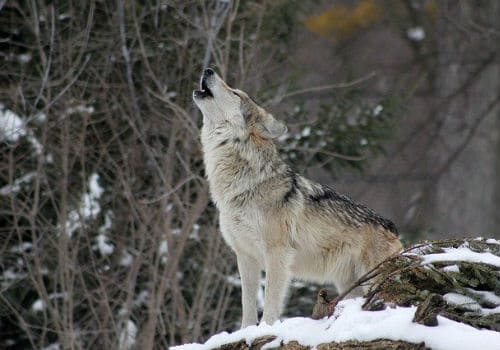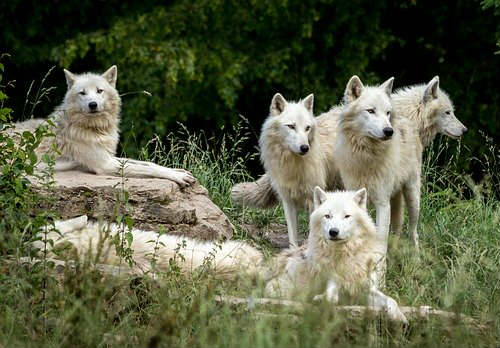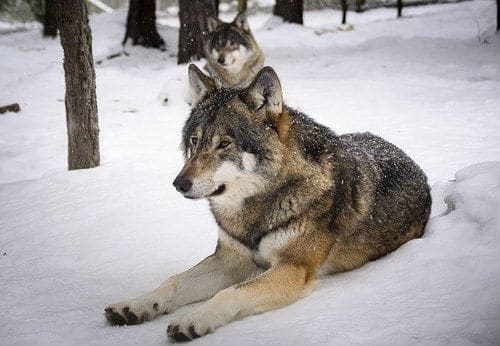In a side-by-side comparison, wolves and dogs share many similarities.
The stellar sense of smell, the pack mentality, and the soulful howl are just a few of the things wolves and dogs have in common.
But the lovable little four-legged scamp who lives in your home is a far cry from its wild ancestors.
We can trace the domestic dog’s lineage back thousands of years. But just what did the domestication process look like — and just how similar are wolves and modern dogs?
Let’s follow the canine family tree back to its roots and find out how wolves became dogs.
The Dawn of Domestication

Wolves and dogs are thought to have descended from the Taimyr wolf, a massive wolf that roamed what’s now Europe as far back as 80,000 years ago. Long since extinct, the Taimyr wolf ate huge prey like bison and mammoths.
But then, the species diverged into two distinct species that still exist today: the grey wolf and the domestic dog.
That divergence occurred due to human involvement: domestication.
The exact timeline of domestication is disputed. Fossil records place the latest possible domestication date at 15,000 years ago.
In 1997, researchers examined dog DNA and suggested that human domestication of wolves began a whopping 130,000 years ago — long before the dawn of agriculture.
And yet another theory posits that domestication occurred twice: once in Europe and separately in East Asia. The timeline of this theory places the divergence at 20,000 to 60,000 years ago.
But researchers have analyzed dog and wolf genetics and devised a new hypothesis. The newest theory claims that domestication happened around 40,000 years ago in a single event.
When Wolves Met Humans

Regardless of when domestication began, the process likely began quite subtly.
Some legends suggest that domestication began when an ancient hunter-gatherer rescued an injured wolf, gaining its trust and becoming its friend.
But there’s no scientific evidence to support this. What actually happened has less to do with human involvement and more to do with canine instinct.
Both modern and ancient wolves are famous for their ability to cooperate and coordinate with one another. This “pack mentality” allows wolves to take down huge prey animals and carry out improbable attacks.
And in tough times, wolves may have extended their cooperative inclinations towards humans as well.
As humans developed better tools and hunting techniques, they began killing more than they could consume. The leftover carcasses attracted wolves, who learned to connect the free meals with the humans who left them behind.
Wolves that were more tolerant of humans were willing to get closer to them. And the closer they got, the more fresh food they were able to scavenge.
Humans, curious by nature, would no doubt have noticed the wolves trailing them. And they would have been drawn to the friendliest wolves, perhaps throwing them extra meat scraps or engaging in play.
As territorial animals, friendlier wolves would have begun staking out human settlements as their territories. They would growl at intruders and attack any invaders, which had benefits for humans as well.
The wolves may not have intended to defend the humans they shared their territory with. But it was a byproduct of their instinct that helped to endear us to them.
Survival of the Friendliest

The more well-fed an animal is, the better able it is to reproduce. That goes for humans, wolves and just about all other animals.
Friendlier and less-fearful wolves, then, would be able to feed more readily on humans’ hunting leftovers. With full bellies, they’d be able to reproduce more readily, passing on those friendly and fearless genes.
Over time, those genes would become predominant in the wolf population. This would pave the way for wolves to domesticate themselves into dogs.
Self-Domestication and Visual Changes
Wild wolves tend to look very similar: they share facial structures, coat lengths and colors, ear shapes and body types.
But domestic dogs, even those of the same breed, can look very different. Ear floppiness, coat patterns and fur colors vary wildly.
That’s due to the phenomenon of self-domestication: when a species acclimates itself to humans and evolves to coexist with them. Humans didn’t intentionally domesticate wolves — they adapted themselves to survive alongside us.
When a species evolves to become friendlier to humans, its physical appearance becomes more varied. These variances have more visual appeal to humans — catchier patterns, “cuter” shapes and so on.
The combination of increased visual appeal and increased friendliness caused wolves and humans to grow closer relatively quickly.
And as these variances became more pronounced, wolves stopped being wolves and officially became domestic dogs.
Grave Conclusions

Once wolves became domestic dogs, our two species were inextricably linked. Dogs evolved to look and behave in ways that were appealing to us, and we evolved a desire to care for them.
We can see evidence of our bond with dogs in ancient burial sites.
At Bonn-Oberkassel in Germany, a 14,000-year-old grave was discovered containing a man, a woman, and a puppy.
Analysis of the puppy’s remains suggested that it died at 28 weeks of age after contracting canine distemper at 19 weeks of age. For a dog to survive that long with distemper, it must have received care and comfort from humans.
The fact that the puppy was buried with two humans suggests that it was considered a member of the family. It’s the way we view our dogs today: not just animals, but honorary people.
Other burial sites around the world have been found to contain ancient pet dog remains. In Utah, 11,000-year-old dog remains (PDF link) were discovered in Danger Cave.
And these remains exhibit a great deal of variation that suggests the existence of different dog breeds.
The bones of small dogs (under 17 inches tall) have been found in Germany, Switzerland, France, and Spain, with remains dating back up to 15,000 years.
Meanwhile, the remains of large dogs (greater than 23 inches tall) have been discovered in Germany, Russia, and Ukraine. These date back 13,000 to 17,000 years, suggesting that these large dogs coexisted with much smaller dogs of the same species.
Shaping a Species
Dog breeds likely began diverging on their own due to the disparate populations of dogs and humans evolving independently. Thousands of years of this created natural breeds with wildly different genes.
There’s also evidence that humans started breeding dogs for specific purposes thousands of years ago. In southwest Asia, herding dogs were bred as long ago as 7,000 years; sled dogs were bred in Siberia up to 9,000 years ago.
But 500 years ago, the dog breeding craze really took off. Breeds were created not to do specific jobs, but to look and behave in unique ways.
By selectively breeding for desired qualities, humans created over 360 different breeds that exist today.
Breed clubs and dog shows started taking off in 19th century Britain. This transformed dog breeding from a utilitarian practice to a hobby and created many of the modern world’s most famous dog breeds.
Today, certain breeds look unmistakably like their wolf ancestors: Siberian Huskies, Malamutes, and German Shepherds all share many physical qualities with wolves.
At the same time, you’d be hard-pressed to see the similarities between a Chihuahua or a Yorkie and a wolf.
But despite their differences, all domestic dogs are of the same species. And though it took tens of thousands of years, that species evolved directly from majestic wild wolves.


this is cool